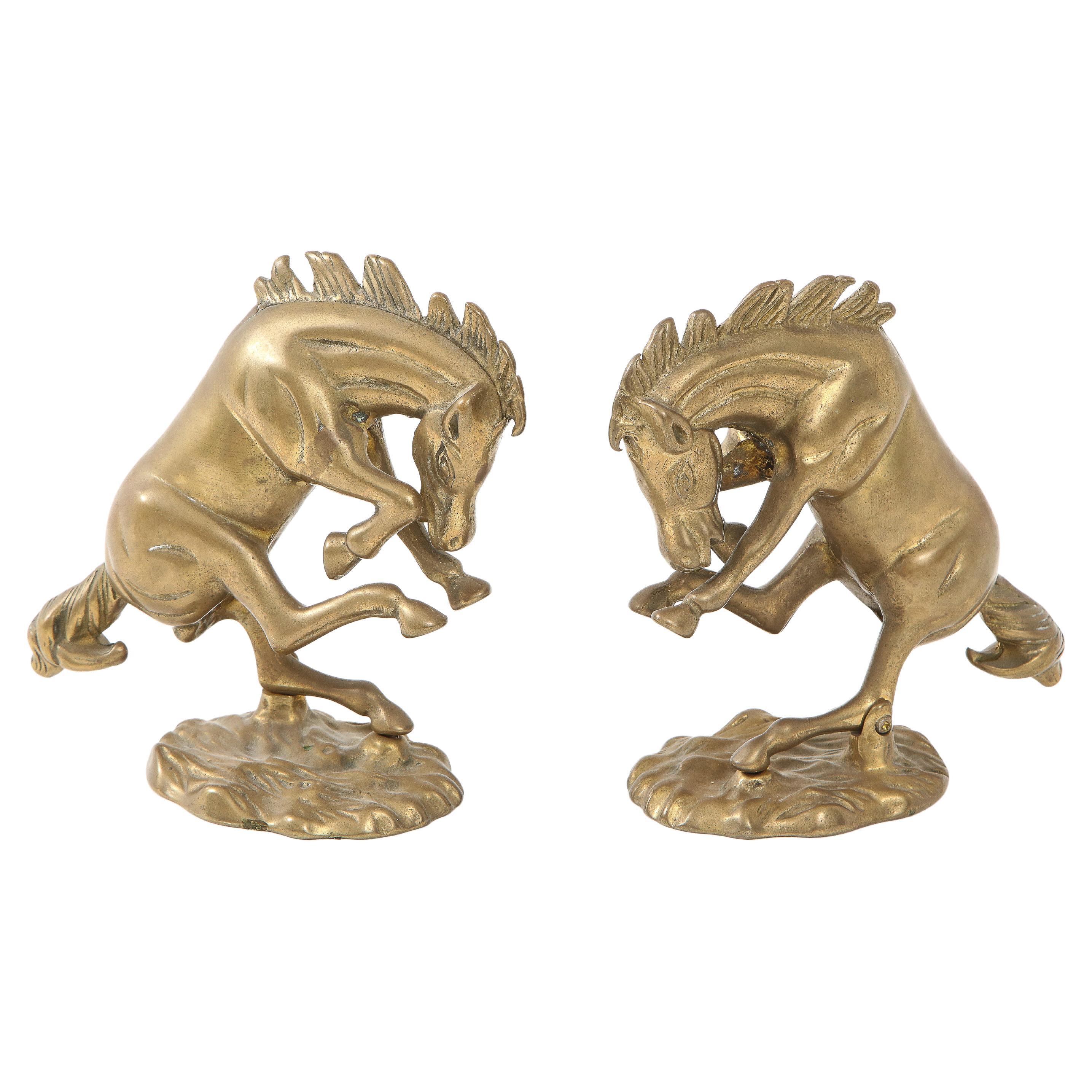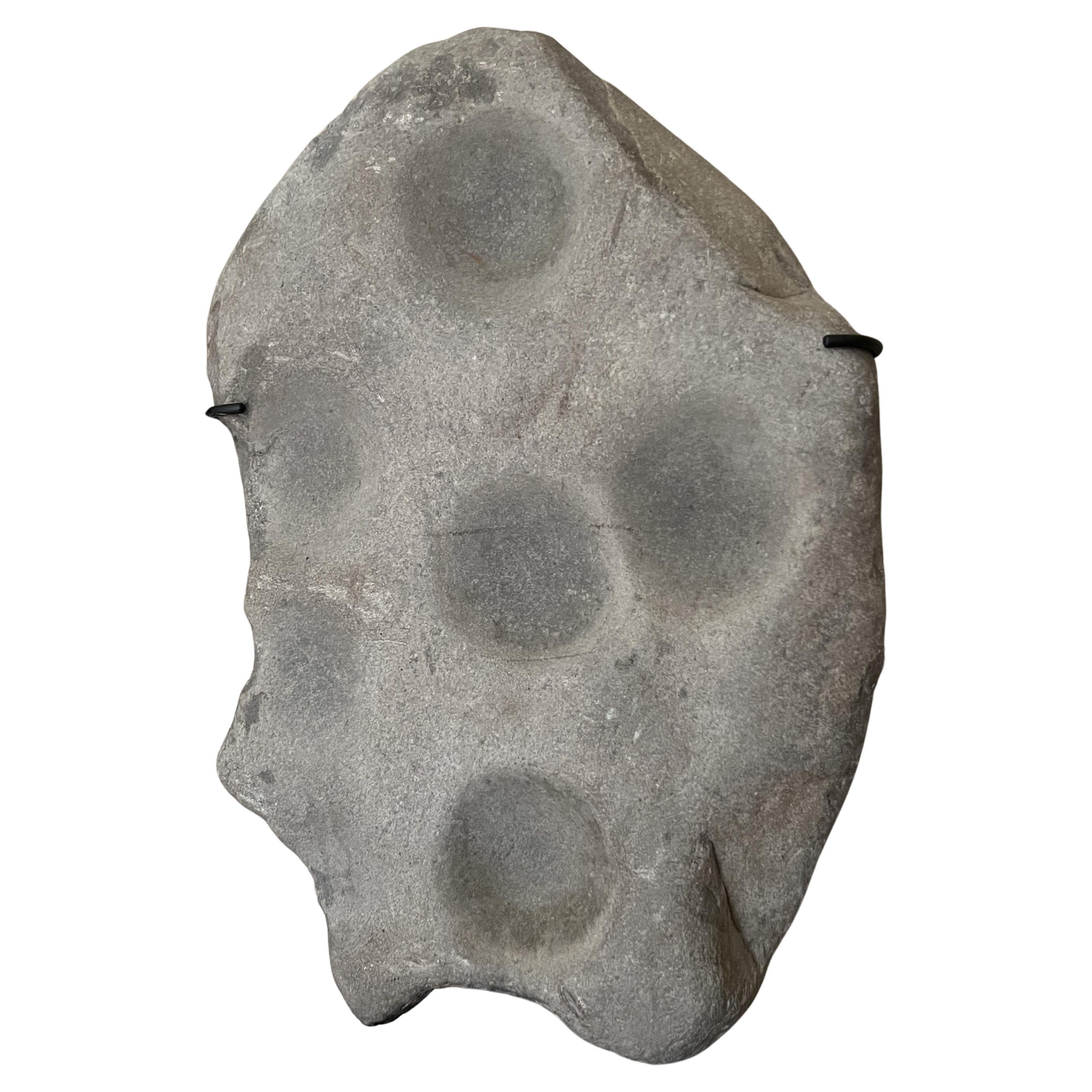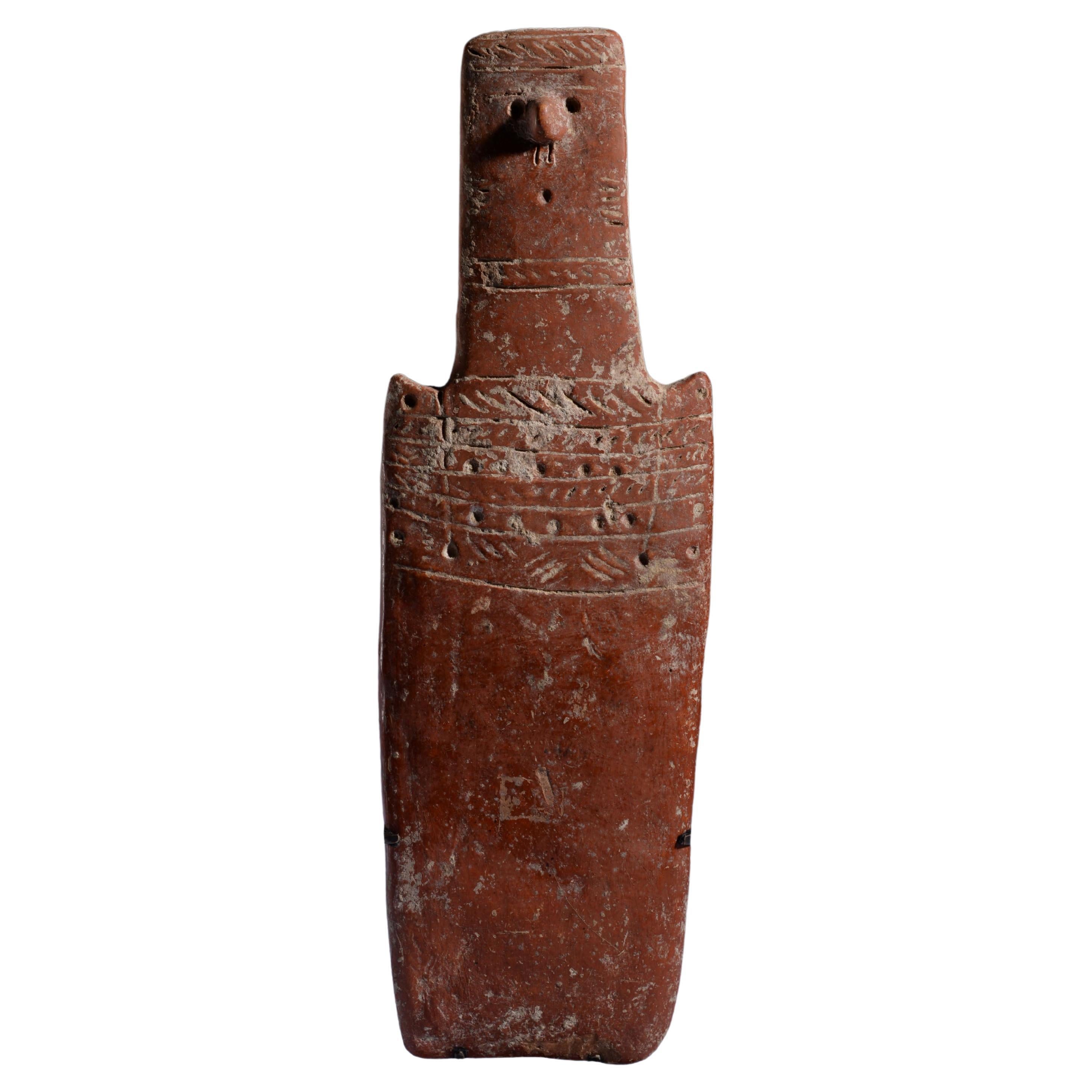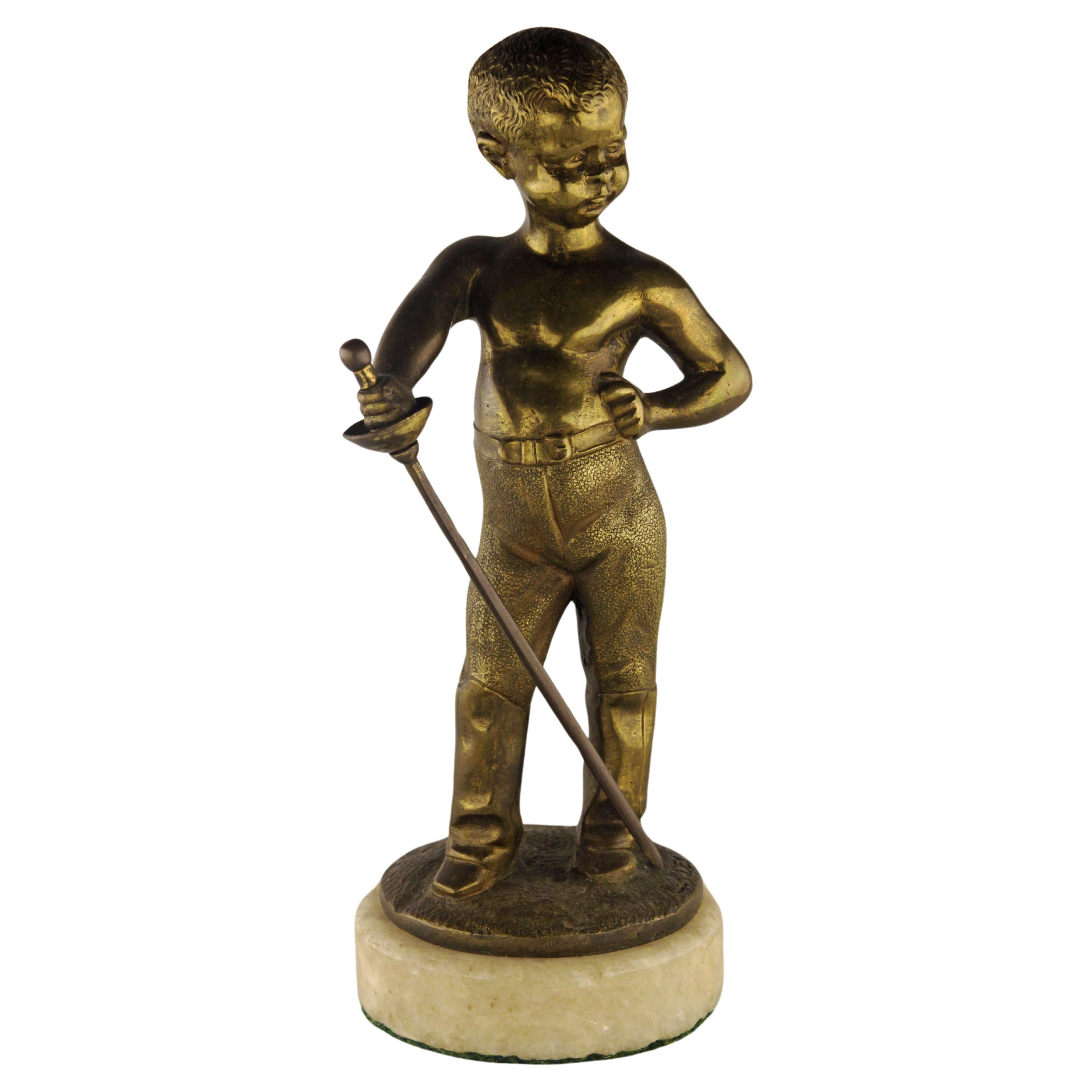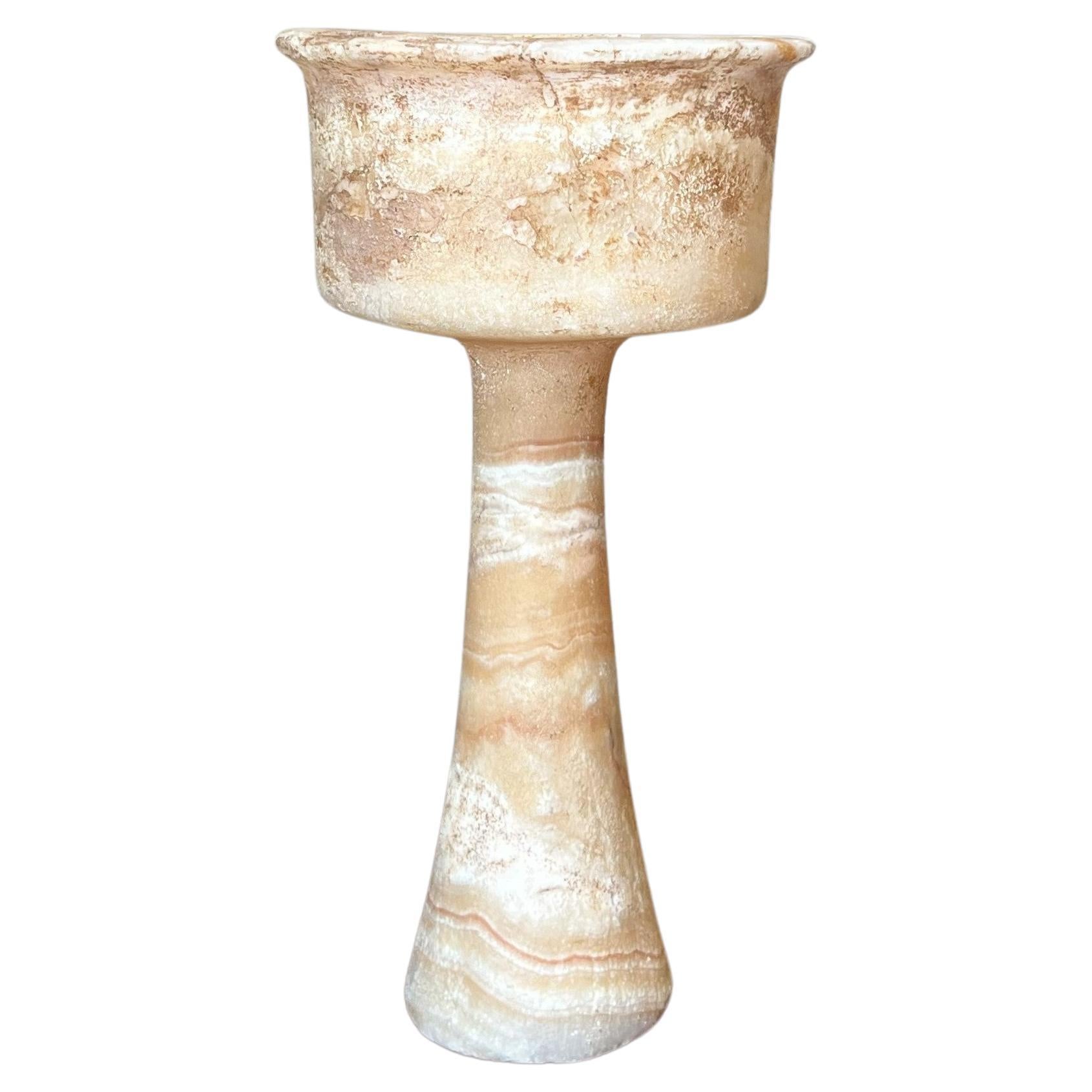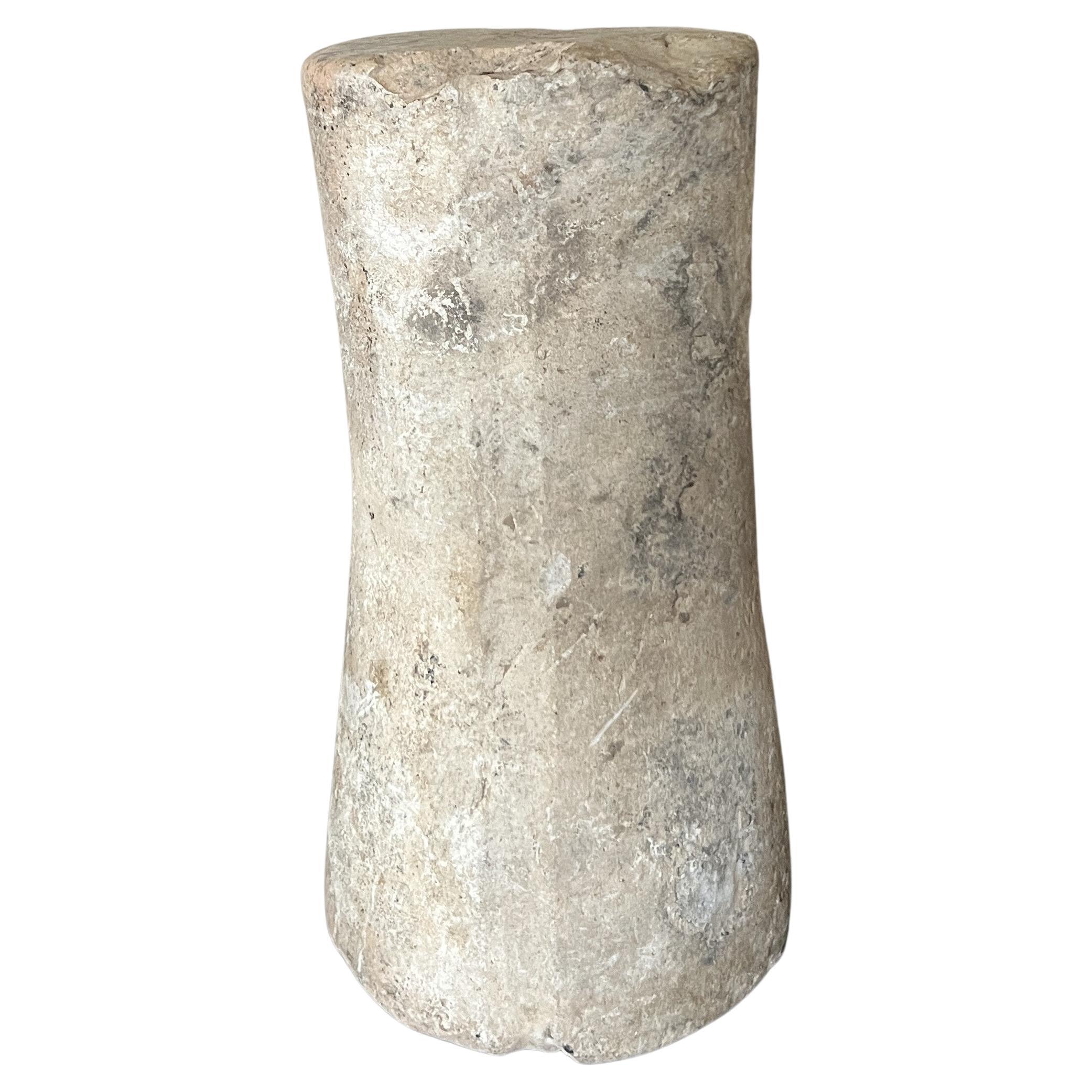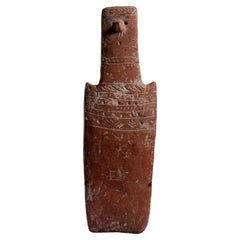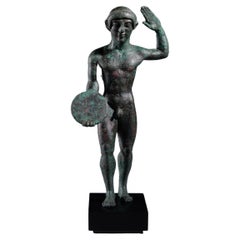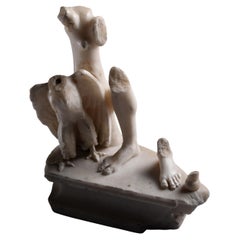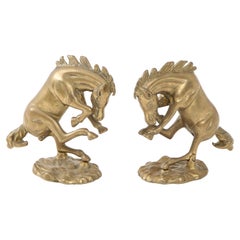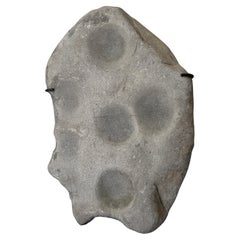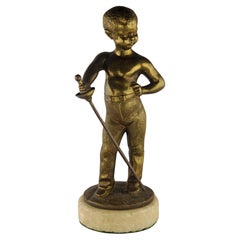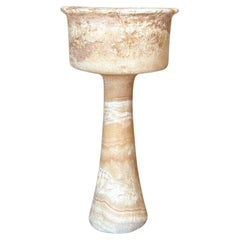Want more images or videos?
Request additional images or videos from the seller
1 of 8
Late Bronze Age Sword
About the Item
Saint Nazaire Sword, Late Bronze Age, circa 800-900 B.C.
An exceptionally well preserved Bronze Age sword, with elegant, finely incised decorations, near perfect form and a wonderful, golden patina. Subtly leaf shaped and tapering to a fine point, this handsome bronze weapon is characteristic of an Atlantic sword of the Saint-Nazaire type. It has a tripartite flanged hilt, with straight horns and seven piercings for rivets to fasten a handle, five of which are still present. Five finely incised lines run from the notched ricasso along and around the raised midrib. The Saint-Nazaire type represents a transitional phase between the leaf-shaped and the so-called carp’s tongue swords of the Atlantic coastal areas of France in the Late Bronze Age.
This sword was most likely recovered from the bed of the River Saône, near Lyon, France, as suggested by the inscription “Saône-Près-Lyon” on the side of the hilt. The recovery of swords in rivers is a strong reminder of their past spiritual significance; the cult of the waters was particularly prominent during the Bronze Age, and it is highly probable that the present sword was deposited as a ritual offering to the river in which it was recovered, millennia later. The River Saône in particular is a very rich ground for the discovery of Bronze Age artefacts, and notably of Late Bronze Age swords. The retrieval of several Atlantic swords in the Saône, such as the present example, illustrates the numerous contacts and exchanges which must have taken place between the Atlantic and Continental cultural complexes at the time.
The development of bronze smithing in Europe coincided with the emergence of a new warrior elite, known to us from their elaborate burials, presiding over a network of competing chiefdoms. These masterfully crafted swords served to demonstrate their rank, and illustrate to us that this was a profoundly warlike culture, in which combat ability was highly prized. Indeed, recent studies, investigating the use-wear on weapons such as this, and what this can tell us about how those who wielded them fought, seem to suggest that Bronze Age swordsmanship was a carefully studied discipline, and that warriors of the period were a dedicated and highly trained class within their contemporary society.
“The weapons of the bronze age, the beauty of which arrests the attention of the most careless observer . stamps the ancient bronze workers not only as skilled mechanics, but as art work- men.”
Robert Day, Ulster journal of Archeology (1895)
Length: 71 cm (28 inches).
Provenance:
Recovered from the River Saône, near Lyon [according to a handwritten inscription on the hilt].
Collection of Monsieur F. B. (1950-2009), Normandy, France.
Subsequently French art market 2021 and exported under French Cultural Property Passport 233626.
- Dimensions:Height: 27.96 in (71 cm)Diameter: 2.37 in (6 cm)
- Materials and Techniques:
- Place of Origin:
- Period:
- Date of Manufacture:800 - 900 BC
- Condition:
- Seller Location:London, GB
- Reference Number:1stDibs: LU1052234448392
About the Seller
5.0
Recognized Seller
These prestigious sellers are industry leaders and represent the highest echelon for item quality and design.
Established in 2008
1stDibs seller since 2014
100 sales on 1stDibs
Typical response time: 2 hours
Associations
LAPADA - The Association of Arts & Antiques DealersInternational Confederation of Art and Antique Dealers' AssociationsThe British Antique Dealers' Association
- ShippingRetrieving quote...Shipping from: London, United Kingdom
- Return Policy
Authenticity Guarantee
In the unlikely event there’s an issue with an item’s authenticity, contact us within 1 year for a full refund. DetailsMoney-Back Guarantee
If your item is not as described, is damaged in transit, or does not arrive, contact us within 7 days for a full refund. Details24-Hour Cancellation
You have a 24-hour grace period in which to reconsider your purchase, with no questions asked.Vetted Professional Sellers
Our world-class sellers must adhere to strict standards for service and quality, maintaining the integrity of our listings.Price-Match Guarantee
If you find that a seller listed the same item for a lower price elsewhere, we’ll match it.Trusted Global Delivery
Our best-in-class carrier network provides specialized shipping options worldwide, including custom delivery.More From This Seller
View AllBronze Age Cypriot Plank Idol
Located in London, GB
Cypriot Plank Idol
Early Bronze Age III - Middle Bronze Age I, c. 2100 - 1850 BC.
Low fired burnished earthenware pottery with lime-filled incisions
A Cypriot plank idol, an iconic form of human representation from Bronze Age Cyprus...
Category
Antique 15th Century and Earlier Cypriot Abstract Sculptures
Materials
Terracotta
Etruscan Bronze Statuette of Discus Thrower
Located in London, GB
A remarkably fine example of Archaic sculpture. A figure of a discophoros, or discus bearer, standing with his right leg forward, gripping a discus in his right hand, the left arm raised with an open palm. Described with admiration in Münzen und Medaillen's 1961 auction, "The figure is a masterpiece and illustrates with rare vividness the essence of good Etruscan sculpture...
Category
Antique 15th Century and Earlier Figurative Sculptures
Materials
Bronze
Large Sculptural Iron Meteorite
Located in London, GB
Stony-iron, pallasite - PMG
Circa 4.5 Billion y/o
Weight: 34.68 kg
Height (including base): 53 cm
Width: 29 cm
A magnificent and extremely sculptural specimen of the Seymchan meteor...
Category
Antique 15th Century and Earlier Natural Specimens
Materials
Iron
Roman Marble Statuette of Jupiter
Located in London, GB
Roman Marble Fragment of jupiter
Circa 2nd-3rd Century A.D.
Measure: Height: 19.7 cm
This beautiful Roman fragmentary statuette depicts Jupiter, the king of the gods, here recognisable from his two chief attributes, the eagle with outstretched wings - according the Pseudo-Hyginus, singled out by Jupiter because ''it alone, men say, strives to fly straight into the rays of the rising sun'' - and the base of the scepter, which remains at the side of the left foot, an aspect likely borrowed from the statue of Zeus at Olympia, once one of the Seven Wonders of the World. Though much of the original piece has been lost, the subtle anatomical detail in the feet mark this out as a piece of exceptional quality, and the work of an artist of particular talent and patience - as Johann Winckelmann once said of the famous Belvedere Torso, ''if you contemplate this with a quiet eye [...] the god will at once become visible in this stone.''
This fragment once caught the eye of Henry Howard, 4th Earl of Carlisle (1694-1758), a Knight of the Garter and among the most prolific collectors of his day. The piece, acquired during his travels to Rome, was proudly displayed on an alcove of the Western Staircase of Castle Howard...
Category
Antique 15th Century and Earlier Italian Classical Roman Figurative Scul...
Materials
Marble
Roman Marble Head of Sophocles
Located in London, GB
Roman Marble Head of Sophocles
Circa 1st-2nd Century
Marble
This fine Roman marble head preserves the proper left side of the face of a middle-aged man, with broad nose, soft lips, and bearded chin. The short beard and sideburns have been finely carved with a flat chisel, to render the soft, wavy strands of hair. The cheekbone, undereye, and nasolabial folds have been delicately modelled in the marble by a skilled hand. In a letter from 1975, the former director of Ny Carlsberg Glyptotek, Copenhagen, suggested that the head could depict the Ancient Greek tragedian Sophocles.
Few figures in the Classical world stand aside Sophocles (c. 496-406 BC), inarguably the best known of the Athenian tragedians, in terms of the impact his works have had on the history of art and literature. The psychological depth he achieves in the seven of the 123 of his plays that have survived to the present day - most notably the three Theban plays: Antigone, Oedipus the King, and Oedipus at Colonus - not only inspired the Athenians, among whom Sophocles was honoured as a hero long after his death, but in our own time, have provoked landmark works on phychoanalysis and literary criticism, by thinkers like René Girard and, most famously, Sigmund Freud. In its masterful treatment of the marble this fragment sensitively captures the features of one of the most important playwrights of all time.
Height on stand: 7.9 inches (20 cm).
Provenance:
Collection of Danish sculptor Jens Adolf Jerichau...
Category
Antique 15th Century and Earlier Classical Roman Busts
Materials
Marble
Cross Section of Exceptional Lunar Meteorite
Located in London, GB
“This 149-gram slice of the Gadamis 004 lunar meteorite contains a wide variety of sizes of light-colored angular anorthositic clasts. These silicate c...
Category
Antique 15th Century and Earlier Libyan Natural Specimens
Materials
Stone
You May Also Like
Aged Bronze Bucking Broncos
Located in New York, NY
Pair of mid century Bucking Bronco horse figures with articulating back leg.
Category
Mid-20th Century American American Classical Animal Sculptures
Materials
Bronze
$495 / set
bronze age ceremonial cup stone
Located in Vosselaar, BE
This peculiar archeological piece is described as a 'cup stone'. These cup marked stones have been found worldwide and been dated from 300.000 bc up to 1000 bc. The exact purpose of ...
Category
Antique 15th Century and Earlier Scandinavian Archaistic Mounted Objects
Materials
Stone
Late 19th Century French Bronze Sculpture of a Boy with a Sword by Louis Kley
By Louis Kley
Located in North Miami, FL
Late 19th century french bronze sculpture of a boy with a sword by Louis Kley
By: Louis Kley
Material: bronze, alabaster, copper, stone, metal
Technique: cast, patinated, molded, me...
Category
Antique Late 19th Century French Belle Époque Figurative Sculptures
Materials
Alabaster, Stone, Bronze, Metal, Copper
Large Bactrian Bronze Age Alabaster Chalice
Located in Vosselaar, BE
Bactrian alabaster chalice, circa 3000-2000 BC. It has an elegant tapering formed base with a undeep rimmed cup. The alabaster is strikingly vained. ...
Category
Antique 15th Century and Earlier Afghan Archaistic Antiquities
Materials
Alabaster
Bactrian Bronze Age Marble Column Idol
Located in Vosselaar, BE
Bactrian marble column idol, circa 3000-2000 BC. It has an elegant tapering form with a undeep groove running on the top. The colomn has incrustation on the side where it laid on the...
Category
Antique 15th Century and Earlier Afghan Archaistic Antiquities
Materials
Marble
Asia Horse Animal Bronze, Late 19th CenturyAsia Horse Animal Bronze, Late 19th C
Located in Marseille, FR
Animal bronze horse Asia (?). The dimensions are 16 cm high, 23 cm wide and 7 cm deep estimated time late XIX th.
Additional information:
Material: Bro...
Category
Antique Late 19th Century Animal Sculptures
Materials
Bronze
